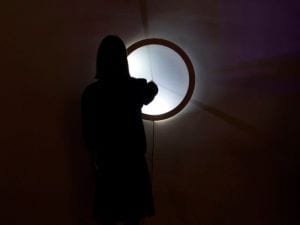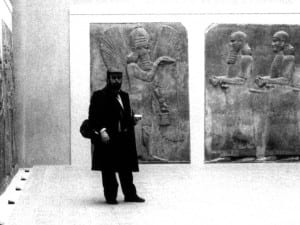Taking its title from a 1985 dystopian novel, New Romance displays technologically advanced artworks and reframes the human condition.
Dystopian worlds, fusions of nature and technology, cyborgs and transhuman images have come to dominate exhibitions over the past ve years, as artists and curators discuss the Anthropocene and the posthuman. These terms appear regularly, but what do they really mean and why have they become such common points of reference for art?
The Anthropocene is a theme which is growing in popularity with each exhibition, and refers to the new geological era that the Earth has supposedly entered: leaving the Holocene for a new era in which humans dominate the Earth’s fabric more than any other influence. It has been recognised that as a race we have fundamentally changed the biology and geology of the planet: numerous species are driven to extinction whilst we create new life forms through gene technology, up to four billion tonnes of ice is melting each year, we are creating new “technofossils” through landfill – a fossilised biro for example – and equally, there is now enough plastic found on our rocks to wrap the Earth with cling film. Facts such as these are leading artists to illustrate our impending doom, or more optimistically, to seek technological solutions.
Posthumanism, meanwhile, has many definitions: reaching into life on Earth, after the human being, into Transhumanism whereby people are technologically altered to live longer and better – and even into ideas of an Artificial Intelligence Takeover – but most commonly looking past Humanism, which emphasises our value, and instead considering us as an equal part of a global system. In looking at our race as part of the Earth, rather than controlling nature, Posthumanism can provide alternative understandings of the Anthropocene.
New Romance: Art and The Posthuman, a new exhibition of works from Australian and Korean artists that takes place at the Museum of Contemporary Art in Sydney, uses this perspective to question humanity’s place in the world now and what it might become in the future. It is a partnership between the gallery and the National Museum of Modern and Contemporary Art in South Korea. MCA curator Anna Davis explains that “although there are many de nitions of Posthumanism, Houngcheol Choi (MMCA, South Korea) and I were most interested in reframing relationships between humans, nature and technology by questioning old definitions of what we see as natural or artificial, human or non-human.” The result is an energetic mix of installation, new media and active sculpture which simultaneously incorporate and reject contemporary technologies, pointing to 1970’s retro-utopias as much as futuristic dystopias.
Pooled from studio visits mostly across Sydney and Seoul and born from the 1940s to the 1980s, the selected artists display a diversity of perspectives, yet there is a discernible difference between the approaches of Australia versus South Korea. Environmentalism and ecology have been a consistent concern for artists working in the former. In Seoul, which has been hailed as the world’s most technologically linked city (alongside London), Davis “sensed that there was a real need for people to engage with the new media landscape that they were deeply embedded into – I felt that it was quite pressing in Korea.” This conversation emerges in the works of artists such as South Korean Airan Kang, whose Digital Book Project critiques the way we live in spaces connecting the virtual and the physical. Her “books” sit on shelves as if in a conventional library; yet, formed from LEDs within clear plastic covers, they glow luminescent to “give the impression of being in a virtual space.” Although the “texts” cannot be reached and read, visitors can browse the library by downloading them via a free app, somewhere between reading an e-book and visiting a physical literary space.
Kang’s work also reflects on the persistence of the analogue: the fact that bound books remain popular in spite of the more economical, easily readable data which is globally accessible. Although Kang makes use of new technologies, his nostalgic perspective is similar to that in the works of the Australian artists in New Romance, which engage with the retro notion of cyberpunk. Initially a 1980s science ction movement, novels, games and films were often set in a futuristic post-industrial dystopia in which technological change had caused social breakdown and cultural unrest, and where the protagonists – generally punk-inspired mis ts – often fought against mega-corporations or artificial intelligence.
The fear and rejection of technology in this genre is displayed by Australian artist Ian Burns, whereby the artist takes on the role of inventor or hacker to combine everyday objects until they make one another near obsolete – a comment on the over-automated systems we now experience daily. Blender (2014), for example, uses a hacked keyboard, a timing system and series of computer-controlled light bulbs to project the lyrics of Pretty Vacant by the Sex Pistols through tiny magnifying glasses onto a wall; meanwhile, its electronic keyboard repeatedly plays ABBA’s SOS aloud and activates a kitchen blender, which mixes dish washing liquid into “the colour of urine” in a salute to the punk movement.
This use of humour allows a range of different entry points into an otherwise serious and challenging discussion, and, as Davis attests, the rejection of technology is a common theme amongst the younger artists who feature in the exhibition. Davis explains: “I have noticed a nostalgia for the pre-internet time. Young artists seem to be interested in changing technologies and amongst the Australian artists in the show there seemed to be a common DIY hacker punk mentality.”
In fact, the namesake for New Romance is seminal cyberpunk text Neuromancer, written by William Gibson in 1984, a novel which managed to predict our present technological era with near exactitude. As Davis recalls, she and MMCA curator Choi held curatorial discussions over Skype for the rst few months of preparation, which were often interrupted with mistranslations and misunderstandings: when Davis mentioned Neuromancer, it transpired that the novel had been published in South Korea but with the incorrect title New Romance and therefore was presumed to be a romance novel. This seemed tting for a collection of works with such powerful emotional and sensorial pull, whilst there is an uncanny parallel between the apocalyptic images of New Romance and the sublime impressions of natural disaster that were conjured by 19th century Romantic painters.
Young New Zealand-born artist Hayden Fowler’s installations set up a surreal mix of artificial worlds in which humans desperately attempt to repossess nature after it has already been lost. For example, displayed in New Romance is public installation Dark Ecology (2015/2016): a geodesic dome which appears to be a remnant of a utopian society, mirroring those envisioned by architects in the 1960s, yet containing a ruined world of blackened trees and scorched earth which men in grey suits enter at times to tend or try to restore to health. Similarly concerned with the social function of art are South Korean artist duo Moon Kyungwon and Jeon Joonho, whose incredibly immersive and stirring two-channel video installation EL FIN DEL MUNDO (2012) follows a man and a woman across separate screens as they go about their daily life. The two characters both seem to have survived a catastrophe, leaving them isolated and alone: whilst on one screen the man struggles in a dingy studio amidst the devastation, the opposite screen shows the woman working busily in a brightly lit lab, arranging test tubes in her pristine white outfit. The audience is unsure if the two scenes take place in the same place and time, although at one point the young woman picks up a string of decorative LED lights and places them over her head as if remembering the lights as objects the man picked up just moments before.
As Davis acknowledges, Moon and Jeon question the meaning of art if we are facing environmental apocalypse, a question that “many artists are asking of themselves now: in a world where so much is happening what is the point in art and what can art do?” Davis also notes that it is important for an institution to question how to curate in these conditions as a serious message can lose intensity if repeated too often.
An oversaturation of fear or dystopian imagery is avoided by Ian Burns as he presents bizarre DIY machines, or Wade Marynowsky, who brings the audience into contact with an inflated, self-important robot which speaks in a snobbish British accent whilst twirling in a frilly gown in The Discreet Charm of the Bourgeois Robot 2 (2010). Perhaps the most bizarre experience for viewers is a visit to the Land of One Thousand Distractions via Justin Shoulder’s performance The River Eats (2012-2015) in which the Sydney-based artist takes on the guise of Pinky, a hyperactive, neon pink creature which slowly transforms into an insect-like hybrid of information and being. As Shoulder explains, “Pinky has been manipulated by Tumblr and Pinterest, his eyes compelled to scan and devour vast torrents of images, categorising them into aesthetic mood-boards based on emotions like “middle- class domestic bliss state” and “aspirational vogue object”.
Whilst most reject the infiltration of technology into our body, pioneering Cyprus-born and Melbourne-raised performance artist Stelarc has welcomed cyborgisation after long stating that the human body should be updated. Stelarc has been performing since the 1970s and in 2006 he had an articial ear transplanted onto his arm. The ear cannot currently hear; however, the artist now plans to use his own stem cells to grow an external ear lobe before implanting a Wi-Fi enabled microphone which will be permanently activated so that people all over the world will be able to listen live.
Blender (2005-2006) is a collaboration with Melbourne-based Nina Sellars. Four pressurised gas tanks surround a steel column which supports a clear glass globe, lit-up with a swirl of liquids and solids. The contents are in fact subcutaneous fat from Sellar’s limbs and torso and peripheral nerves. Whilst a soundpiece introduces a pulse, blades inside the globe blend the mixture and then stop to let the materials settle. This is a direct interrogation of what it is to be human: even the beating heart is a reference to Stelarc’s suggestion we will one day avoid biological deaths through turbine hearts. Highlighting that our categorisation of humans, nature and technology is emotionally driven, it forces us to reconsider how the relationships between them will evolve.
Words Chloe Hodge
New Romance: Art and the Posthuman. MCA Australia. Until 4 September.





